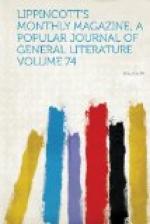Now, however, the glories of the Middle Temple rest chiefly in the past. It has decreased in wealth and in numbers. There is an old proverb which says, “The Inner Temple for the rich, the Middle Temple for the poor;” and a famous wit emphasized this saying by a happy mot. After one of its far from recherchA(C) dinners, he compared a gritty salad, of which he had been unlucky enough to partake, to “eating a gravel walk and meeting an occasional weed.”
The hall of the Inner Temple is a modern building, and was opened by the Princess Louise on May 4, 1870. More spacious than the one it replaced, it contains a number of cosy offices and ante-rooms. There is also attached a lunch-room for the use of members, much frequented in term-time, when at the mid-day hour one may meet many of the great practitioners at the English bar. Passable portraits of William and Mary, Queen Anne, Lord Chief-Justice Coke, and Sir Thomas Littleton look upon the visitor, and the arms of the successive treasurers of the Inn are blazoned on the walls.
The Inner Temple Library is the most attractive, quiet, and convenient of any in the four Inns. Its plan comprises a series of book-lined apartments leading one into another. Besides a valuable and voluminous collection of authorities on legal topics, it possesses a unique array of works on general subjects. It stands on the terrace, and commands a view of the river. The noble hammer-beam roof is a fine specimen of its kind, spanning a chamber forty-two feet wide and ninety-six feet long. One of the stained-glass windows is emblazoned with the Templars’ escutcheon. The debating-hall is in the Tudor style, and cost not far from seventy-five thousand dollars.
Several great jurists and a number of men equally eminent in other walks of life were connected with the Inner Temple, pre-eminent among whom stand Sir Christopher Hatton, Lord-Chancellor of England in 1587, and nicknamed the “Dancing Chancellor,” Lord Tenterden, “one of the greatest Englishmen who ever sat in the seat of Gamaliel,” who was admitted in 1795, and John Selden, who took up residence in Paper Buildings in 1604. The latter were consumed in the great fire of 1666. Audley, chancellor to the eighth Henry, Nicholas Hare, privy councillor to the latter monarch and Master of the Rolls under Mary, who resided in the court which now bears his name, the eminent lawyer Littleton and his no less famous commentator Coke, Lord Buckburst, Beaumont the poet, Sir William Follett, and Judge Jeffries of infamous memory, were all students within the Temple precincts.
Charles Lamb, whose father, John Lamb, was clerk to Mr. Salt, a bencher of the Inner Temple, was born in Crown Office Row. In 1809 he took chambers at No. 4, Inner Temple Lane, where some of the delightful “Elia” essays were penned. In one of these he says, “I was born and passed the first seven years of my life in the Temple. Its church, its halls, its gardens, its fountains, its




